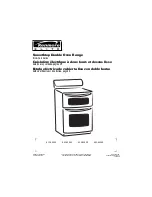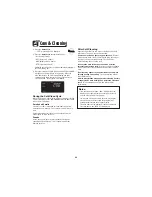
9
To Prevent Marks & Scratches
•
Do not
use glass pans. They may scratch the surface.
•
Never
place a trivet or wok ring between the surface and
pan. These items can mark or etch the top.
•
Do not
slide aluminum pans across a hot surface. The pans
may leave marks which need to be removed promptly. (See
Cleaning, page 23.)
• Make sure the surface and the pan bottom are clean
before
turning on to prevent scratches.
• To prevent scratching or damage to the glass-ceramic top,
do not
leave sugar, salt or fats on the cooking area. Wipe
the cooktop surface with a clean cloth or paper towel
before
using.
•
Never
slide heavy metal pans across the surface since
these may scratch.
To Prevent Stains
• Never
use a soiled dish cloth or sponge to clean the
cooktop surface. A film will remain which may cause stains
on the cooking surface after the area is heated.
• Continuously cooking on a soiled surface may/will result in
a permanent stain.
To Prevent Other Damage
•
Do not
allow plastic, sugar or foods with high sugar
content to melt onto the hot cooktop. Should this happen,
clean immediately. (See
Cleaning
, page 23.)
•
Never
let a pan boil dry as this will damage the surface and
pan.
•
Never
use cooktop as a work surface or cutting board.
•
Never
cook food directly on the surface.
•
Do not
use a small pan on a large element. Not only does
this waste energy, but it can also result in spillovers burning
onto the cooking area which requires extra cleaning.
•
Do not
use non-flat specialty items that are oversized or
uneven such as round bottom woks, rippled bottom and/or
oversized canners and griddles.
•
Do not
use foil or foil-type containers. Foil may melt onto
the glass. If metal melts on the cooktop,
do not
use. Call an
authorized Servicer.
Surface Cooking
Flat Pan Tests
See if your pans are flat.
The Ruler Test:
1. Place a ruler across the bottom of the pan.
2. Hold it up to the light.
3. Little or no light should be visible under the ruler.
The Bubble Test:
1. Put 1 inch of water in the pan. Place on cooktop and turn
control to
HI
.
2. Watch the formation of the bubbles as the water heats.
Uniform bubbles mean good performance, and uneven
bubbles indicate hot spots and uneven cooking.
Cookware Recommendations
Using the right cookware can prevent many problems, such
as food taking longer to cook or achieving inconsistent
results. Proper pans will reduce cooking times, use less
energy, and cook food more evenly.
Select
Avoid
Flat, smooth-bottom
Pans with grooved or warped bottoms.
pans.
Pans with uneven bottoms do not cook
efficiently and sometimes may not
boil liquid.
Heavy-gauge pans.
Very thin-gauge metal or glass pans.
Pans that are the
Pans smaller or larger than the
same size as the
element by 1 inch.
element.
Secure handles.
Cookware with loose or broken handles.
Heavy handles that tilt the pan.
Tight-fitting lids.
Loose-fitting lids.
Flat bottom woks.
Woks with a ring-stand bottom.
Canning and Oversize
Cookware
All canners and large pots must have flat bottoms and
must be made from heavy-gauge materials.
This is critical
on smoothtop surfaces. The base must not be more than
1 inch larger than the element.
When canners and pots do not meet these standards, cooking
times may be longer, and cooktops may be damaged.
Some canners are designed with smaller bases for use on
smoothtop surfaces.
When canning, use the HI heat setting only until the
water comes to a boil
or pressure is reached in the canner.
Reduce to the lowest heat setting that maintains the boil or
pressure. If the heat is not turned down, the cooktop may be
damaged.
Содержание 622.60002
Страница 29: ...28 Notes ...
Страница 30: ...29 ...
Страница 60: ...59 ...
Страница 90: ...Notas 89 ...
Страница 91: ...Notas 90 ...
Страница 92: ...Form No A 01 06 Part No 8113P571 60 2006 Maytag Appliances Sales Co Litho U S A ...











































